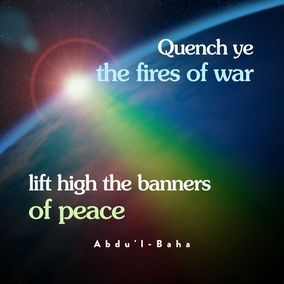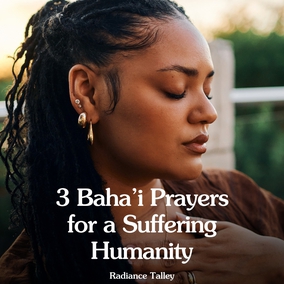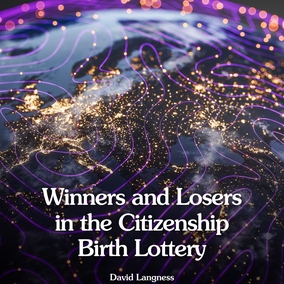The views expressed in our content reflect individual perspectives and do not represent the authoritative views of the Baha'i Faith.
Every journey has at least three stages: the beginning, the middle, and the end. But what about our spiritual journey?
The number three strikingly recurs in many sacred traditions: the three sons of Adam and Eve; the three sons of Noah associated with the three lands they occupied after the flood receded; the three wives of Abraham; the three men in the fiery furnace; the three days of Jonah in the belly of the sea monster; the three Magi; the three crosses on the hill where Jesus was crucified; the three days of the resurrection of Jesus, and so on. There seem to be too many “threes” distributed across too many narratives to be a coincidence. Does the number three symbolize something important spiritually?
The number three repeatedly appears in the ancient narratives in the form of a journey. For example, in the Exodus account in the Tanakh (the Hebrew sacred scriptures), God instructs Moses to demand of the Pharaoh of Egypt:
…now let us go, we beseech thee, three days’ journey into the wilderness… – Exodus 3:18.
The Gospel of Luke in the Christian New Testament reported Jesus’ similar words to the Pharisees when they warned him about King Herod’s nefarious intentions:
Go and say to that fox [Herod], Behold, I cast out demons and perform cures today and tomorrow, and the third day I am perfected. Nevertheless I must go on my way today and tomorrow and the day following… – Luke 13:32.
These two texts seem to tell us something important about a three-day journey. The first sentence in the Gospel text tells us that the journey is about casting out the badness in our lives, healing our spiritual illnesses, and thereby perfecting ourselves; the second tells us that this journey is imperative. In both texts, a temporal tyrant receives the message.
The teachings of the Baha’i Faith describe each person as a wayfarer traveling on a spiritual journey that represents a lifelong process of spiritual growth. If indeed the three-day theme can represent this spiritual journey in symbolic language, then we should expect to find a pattern of three with a connotation of a spiritual journey in some of the Baha’i writings. We find it in Baha’u’llah’s book of aphorisms, The Hidden Words:
O Son of Love! Thou art but one step away from the glorious heights above, and from the celestial tree of love. Take thou one pace and with the next advance into the immortal realm and enter the pavilion of eternity. Give ear to that which hath been revealed by the pen of glory. – p. 24.
As you recite the above text aloud, beginning with “Take thou one pace and with the next …,” move a chess piece from left to right on the game board. Are you done? What exactly has happened? The piece has occupied three positions: the starting square before the first “pace” or move, the second square after the first pace, and the third square after the second pace.
Now imagine yourself as that chess piece, that each square on the game board signifies a spiritual condition in your journey, and that each of the two paces represents a transition or change between spiritual conditions. Baha’u’llah exhorts us to “give ear” to this teaching, to heed his words, and to take action on their meaning. The endpoint of the journey is “the immortal realm,” eternal life in the Kingdom of God, the “pavilion of eternity.”
But what three spiritual conditions do we experience on this journey? Baha’u’llah amplifies on them in The Seven Valleys, in the section called “The Valley of Unity.” He discusses how people (again referred to as wayfarers), owing to their differing degrees of spiritual development, penetrate spiritual matters at different depths, in a pattern of three planes reflective of geography:
Thus, for that they move on these three differing planes, the understanding and the words of the wayfarers have differed; and hence the sign of conflict doth continually appear on earth. For some there are who dwell upon the plane of oneness and speak of that world, and some inhabit the realms of limitation, and some the grades of self… – p. 21.
We can see that Baha’u’llah makes clear qualitative distinctions here, using geography as a vehicle to express the meaning. Elsewhere in The Hidden Words he amplifies again on these three spiritual conditions and helps us understand their distinctions more clearly:
O friends! Prefer not your will to Mine, never desire that which I have not desired for you, and approach Me not with lifeless hearts, defiled with worldly desires and cravings. – p. 28.
The plane of “grades of self” refers to living a life full of worldly desires and cravings, satisfying immediate needs of a self-insistent nature. If we manage to step up and away from this plane, we then enter the plane of limitation, where we discover the capacity of our will power and make appropriate or inappropriate choices, again based on what we feel as obsessive desire. It is a kind of intermediate state between the first and third planes, which we can equate to days one and three on our journey. The plane of limitation is day two, when we struggle to master our own will power. When we master it, we advance into the plane of oneness, our third day, where we merge our will with the will of God, preferring it under all circumstances and leaving self (that mortal tyrant, our personal Pharaoh or Herod) behind. According to the Baha’i teachings, this is what is meant by reunion with God.
In his book Logos and Civilization, the Baha’i scholar, sociologist, university professor, and writer Dr. Nader Saiedi described how the human will operates and reorients itself in these three successive stages of spiritual growth. By taking that journey, we free ourselves from material trappings and the insistent self (words in brackets show correspondence to the three planes described by Baha’u’llah):
In the beginning [the plane of self], the will is predominantly hedonistic and aggressive. The next stage [plane of limitation], some form of moral values is accepted but without serious transformation of the will. The result is inner conflict, guilt, and struggle against lower impulses. In the stages that follow [the plane of oneness], moral values become increasingly universalized and spiritualized, and the will becomes transformed, progressively reflecting the divine will. – p. 101-102.
The symbol of the three-day journey speaks directly to the process of resurrection. We will explore it as a general model of our collective spiritual journey in future articles.
















Comments
Sign in or create an account
Continue with Googleor